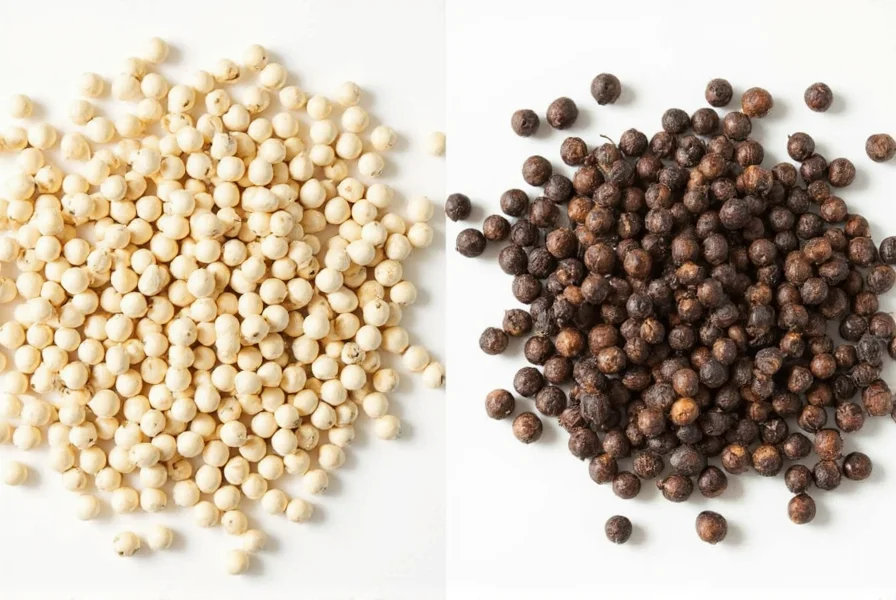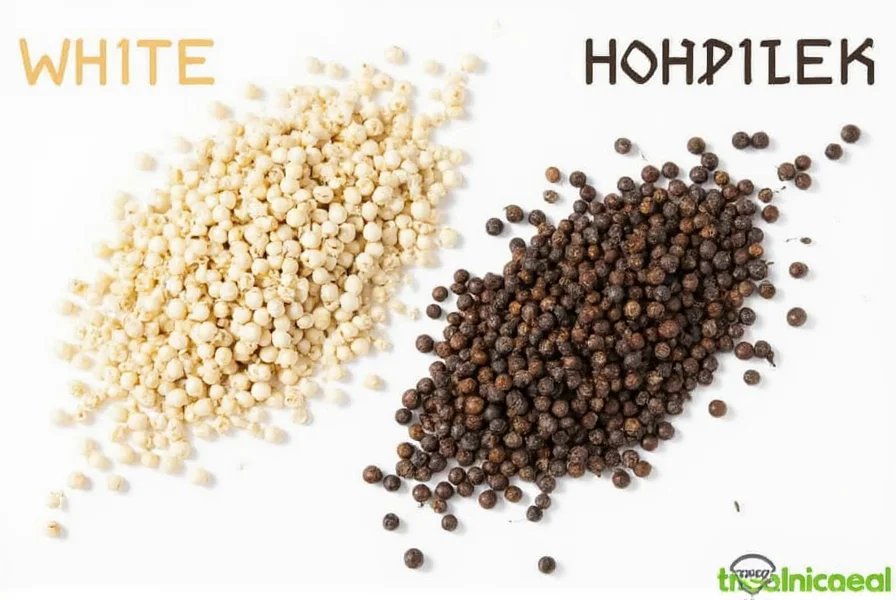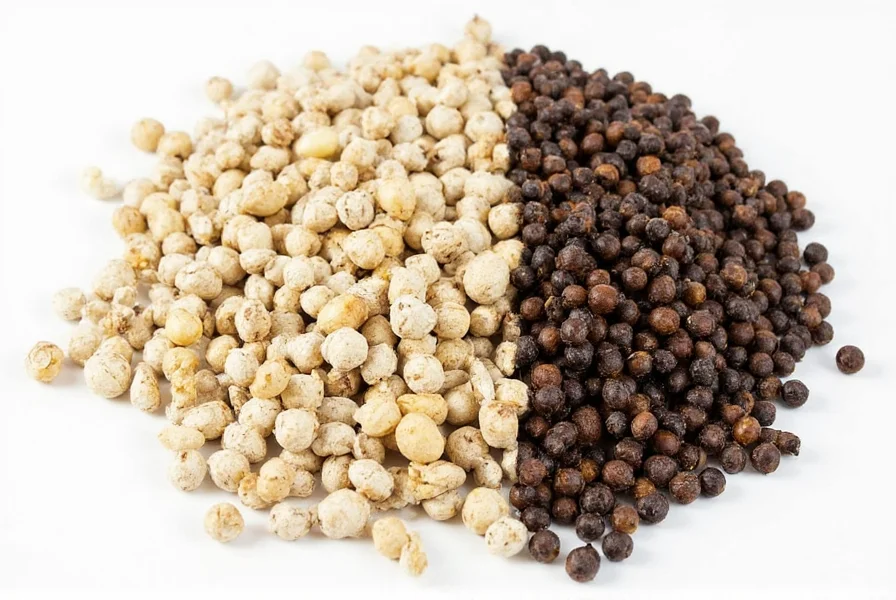Understanding the distinction between these two common spices helps home cooks and professional chefs make informed choices for their culinary creations. Despite coming from the same vine, the transformation from berry to finished pepper creates remarkably different flavor experiences.
Botanical Origins and Processing Methods
Both white and black pepper derive from Piper nigrum, a flowering vine native to South India. The critical difference lies in harvest timing and processing:
| Pepper Type | Harvest Stage | Processing Method | Resulting Characteristics |
|---|---|---|---|
| Black Pepper | Unripe green berries | Berries cooked in hot water, then sun-dried for 1-2 weeks causing oxidation | Dark outer layer, complex flavor with pungency and subtle fruit notes |
| White Pepper | Fully ripe red berries | Outer layer removed through soaking (retting) before drying the seed | Light color, milder earthy flavor with less pungency |
Flavor Profile Comparison
Black pepper delivers a more complex flavor experience with pronounced heat, floral notes, and subtle fruitiness. Its pungency comes from piperine, concentrated in the outer layer removed during white pepper production. White pepper offers a cleaner heat with earthy, musty notes and less complexity. Many chefs describe white pepper as having a "sharper" heat that lingers differently on the palate.
The difference between white and black pepper flavor profile becomes particularly noticeable in delicate dishes. Black pepper's visual specks and robust flavor can dominate lighter preparations, while white pepper blends seamlessly into cream sauces, mashed potatoes, and fish dishes without altering appearance.

Culinary Applications and When to Use Each
Professional chefs select between white and black pepper based on both visual and flavor considerations:
- Black pepper excels in robust dishes like steaks, grilled meats, dark sauces, and hearty stews where its visual specks add aesthetic appeal
- White pepper shines in light-colored preparations including béchamel sauce, potato salad, white bean soup, and Asian cuisine where visual purity matters
- Substitution considerations: When substituting white for black pepper, use slightly less white pepper as its heat builds more gradually but lasts longer
The question of which pepper is hotter white or black has a nuanced answer. Black pepper delivers immediate, sharper heat, while white pepper's heat develops more slowly but persists longer. This difference in heat perception explains why many find white pepper "milder" despite similar piperine content.
Nutritional Differences and Health Benefits
Both peppers contain piperine, which enhances nutrient absorption, particularly curcumin from turmeric. Black pepper retains more outer layer compounds, giving it slightly higher antioxidant content. The difference between white and black pepper nutrition is minimal in typical culinary usage, as both are used in small quantities.
White pepper may be preferable for individuals with sensitivities to certain compounds in the outer peppercorn layer. Some traditional medicine systems favor white pepper for digestive applications due to its different compound profile.
Historical Context and Global Usage
Black pepper has been traded since ancient times, earning the nickname "black gold." White pepper became popular in European cuisine during the Middle Ages when chefs sought visually clean presentations. In many Asian cuisines, particularly Chinese and Vietnamese cooking, white pepper remains the preferred choice for its distinctive flavor in soups and marinades.
The history of white and black pepper reveals cultural preferences that continue today. French cuisine traditionally favored white pepper for its "refined" appearance in sauces, while Indian and Middle Eastern cuisines predominantly use black pepper for its robust flavor.
Storage Recommendations
Both peppers maintain freshness longest when stored in airtight containers away from light and heat. Whole peppercorns preserve flavor significantly longer than pre-ground versions. The difference between white and black pepper storage is minimal, though white pepper may lose potency slightly faster due to the removal of protective outer layers.
For optimal flavor, grind peppercorns immediately before use. Pre-ground pepper loses volatile compounds within weeks, diminishing the distinctive characteristics that differentiate white and black varieties.

Practical Considerations for Home Cooks
When deciding between white pepper vs black pepper, consider both visual and flavor impact on your dish. For most everyday cooking, black pepper provides the familiar flavor profile people associate with "pepper." White pepper serves a specific purpose in dishes where appearance matters or when its unique flavor complements other ingredients.
The culinary uses of white and black pepper often overlap, but understanding their differences allows for more intentional seasoning. Many professional kitchens maintain both varieties to address specific recipe requirements rather than treating them as interchangeable.
Frequently Asked Questions
Can I substitute white pepper for black pepper in recipes?
Yes, but with considerations. Use about 25% less white pepper when substituting for black, as its heat builds differently. White pepper works best in light-colored dishes where black specks would be undesirable, but won't provide the same complex flavor profile in robust dishes that traditionally use black pepper.
Why does white pepper taste different than black pepper?
The flavor difference comes from processing. Black pepper retains the outer fruit layer which contains aromatic compounds that develop during sun-drying. White pepper lacks this outer layer, resulting in a more singular earthy flavor from the seed alone. The retting process for white pepper also creates subtle fermentation notes not present in black pepper.
Which pepper has more health benefits, white or black?
Black pepper contains slightly more antioxidants due to retaining the outer layer, but both provide piperine which enhances nutrient absorption. The difference in health benefits between white and black pepper is minimal in typical culinary usage since both are consumed in small quantities.
Does white pepper go bad faster than black pepper?
Whole white peppercorns maintain freshness slightly less long than black peppercorns because the protective outer layer has been removed. Both stay fresh for 2-3 years when stored properly in airtight containers away from light and heat. Ground versions of both lose potency within 3-6 months.











 浙公网安备
33010002000092号
浙公网安备
33010002000092号 浙B2-20120091-4
浙B2-20120091-4